ACS «TrafficLead»
Automated control system for railway traffic «TrafficLead»
General descriptiom
ACS «TrafficLead» is a specialized solution developed for the implementation of business processes of the company, the main activity of which is the organization of railway traffic.
Link for test access.
Taking into account the specifics of the company's work in this segment of the market, TrafficLead Automation Systems provides functionality for the integrated automation of all divisions of the company, as well as provides the company's management tools for obtaining the necessary reports and analytical data slices in the system, allowing to make management decisions.
Along with specialized capabilities, the automated system "TrafficLead" also contains those that are necessary for the effective operation of any modern company: electronic document management, a multi-level system for differentiating access rights, and a data security system.
Automated control system "TrafficLead" is developed on the basis of advanced software technologies and meets all the requirements for modern enterprise automation systems - consistency and one-time data entry, openness for data exchange with external systems, scalability.
Automated control system "TrafficLead" is built from several basic modules (systems), each of which is designed to automate a specific standard "site" of the forwarding company. When completing the system, it can be installed as a complete set of modules - they will exchange information and work together within a single system, or selectively - each of the modules can be installed separately.
When implementing this project, the following technologies were used:
Database: MS Sql Server 2014.
Used technologies: MVC ASP. NET, Knockout JS, Bootstrap, F # Data, AspNet Identity.
BASIC OPPORTUNITIES
The core of the system is called server software, which implements a set of functions necessary for the operation of any automated control system "TrafficLead". Server software is installed necessarily, regardless of the set of modules included in the configuration of the system. The kernel implements the following functionality:
Electronic document management
The electronic document management system allows you to automate the process of preparation, registration, storage, retrieval of documents and minimize the work of users with paper copies.
Within the general system of electronic document management there are specialized solutions for creating and working with documents of a certain type:
Payment and settlement documents
- Preparation of payment orders, invoices, invoices, etc.
- Automatic filling of documents on the basis of data from the system of operational registration of applications for the organization of railway traffic.
Reports
- Universal interface for setting parameters and generating reports of various kinds. Storage of report parameters and received results in the electronic document management system.
- Automatic setting of parameters when starting the report from various program modes.
- Configuring SQL and VB scripts that prepare reports.
- Receiving reports in various formats - MS Excel, MS Word, TXT.
Contracts, tariff conditions
- Preparation and registration of documents such as "Agreement", with a choice from the directories of the contracting parties and their requisites (including signers, legal and actual addresses).
- Preparation and registration of additional agreements for the organization of transportation (protocols for negotiating a rate). In this case, the following parameters are specified, used in the future when processing the customer's application:
The procedure of settlements, agreed and special tariffs for each of the directions and types of cargo;
Deadlines for the filing of documents (for export).
System of differentiation of access rights
This system provides management of access rights to data and the rights to perform operations on them at the program level and is integrated with all operating modes of all modules of the automated control system "TrafficLead".
Normative and informative reference systems
All the information that TrafficLead system users work with is stored in directories - on the one hand, it provides a uniform interpretation of the data by all the components of the automated control system "TrafficLead", and on the other hand it makes the data work convenient.
Directories of the system:
- Legal persons with the description of registration data (including the names of managers), payment details (in Russian and foreign banks), addresses (legal, actual, etc.), contact information;
- Individuals with a description of various types of identity documents, addresses, contact information;
- Directory of countries;
- СHandbook of cargoes of the GNG and ETSNG;
- Directory of railways and their units;
- Directory of railway stations with indication of belonging to the road, separation of the road and TehPD;
- Other special and service directories.
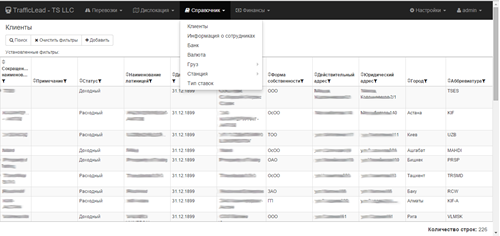
Fig. 1: Customer Reference
System of operational accounting of railway forwarding
Appointment
The system is designed to keep an operational record of interaction with customers on the organization of railway traffic. With its help, the user can perform the following operations:
- Register customer requests for the organization of transportation;
- Calculate the cost of transportation;
- Keep records of planned volumes in sum and quantity terms;
- As the application is being executed, a comparison of the planned and actual works is performed.
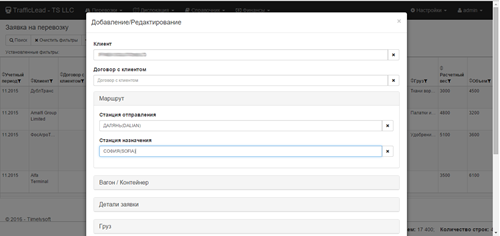
Fig. 2: Adding a customer order for transportation
The system for processing shipping information
Appointment
The system of processing of shipping information and claim work is optimized for working with large arrays of shipping information, coming in electronic form from various sources. The data import / export module allows you to import data of any electronic format, namely: from a database, a correctly formatted MS Excel file or simply a structured text file картинка
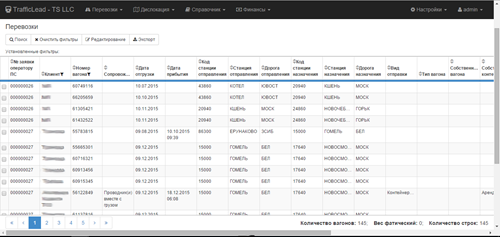
Fig. 3: "Transportation" tab
Financial accounting and planning system
The financial accounting system is self-sufficient and allows you to keep records of one or a group of companies that are united in a holding.
Functionality
- Maintain at the same time several types of accounts.
- A configurable set of analytical features with reference to specific directories, for example: "Contracts", "Legal persons", "Individuals", "Documents", "Reporting periods", "Customer applications", "Services", etc.
- Setting up templates for typical financial transactions with indication of valid correspondence between the accounting registers.
- Maintenance of journals of standard financial transactions (lists of financial documents) with a developed system of searching for necessary information.
- Logging of postings and documents with the possibility of filtering.
- When used in conjunction with other subsystems - automatic reflection (according to customized rules) of planned and actual charges, invoices issued, payments made and other financial information contained in application modules;
- A wide range of operational and financial statements reflecting all stages of the company's activities.
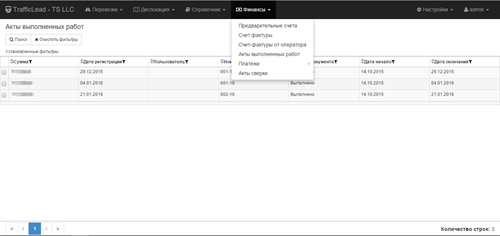
Fig.4 The "Finance" menu
Module "Tracking, management and accounting of rolling stock"
This module of the automated control system "TrafficLead" is designed to solve the following types of tasks:
- Tracking the performance of transportation;
- Operational management of fleet of rolling stock;
- Auto-informing customers about the location of the cargo (e-mail, web-site of the company).
- Accounting for the fleet of own / leased rolling stock and control of its technical condition. Accounting for the relationship of rent, purchase, sale of PS.
Automated control system "TrafficLead" allows to solve these tasks in real time, using the operational data received from the MCC MPS, from roads, repair depots, from other sources.
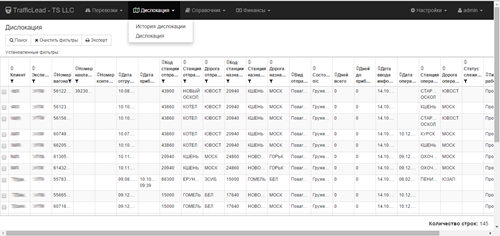
Fig. 5: Tracking of rolling stock
The system of accounting for customer relationships (CRM-system)
The system allows to systematize and take into account the company's relations with customers and partners, and also automate the maintenance of internal projects of the company.
Functionality
- Support of the account of mutual relations with clients, the account of contact persons, the purposes, tasks and results of each of actions;
- Close integration with the document management system and postal services;
- Possibility of preparation and storage of information and documents of arbitrary type;
- Possibilities for constructing a hierarchy of events.
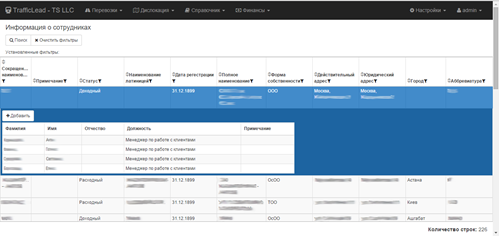
Fig. 6: Employees Information Tab
